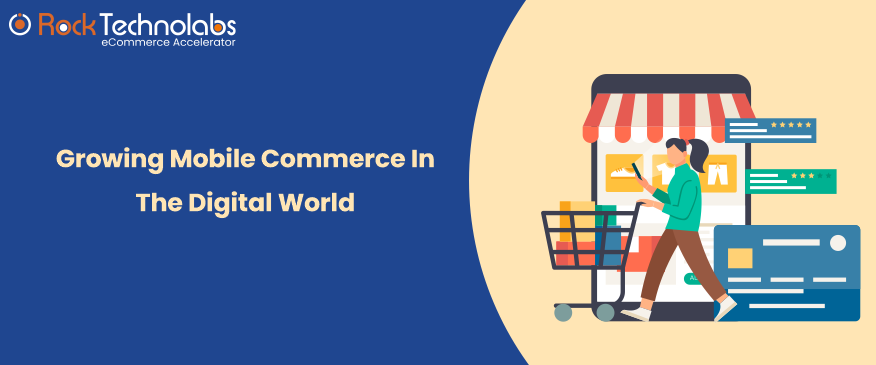What is Mobile Commerce?

To know the mobile commerce definition, you must firstly know that the mobile commerce industry is booming and shows no signs of slowing down. In fact, over the next few years, it is anticipated that most purchases will be carried out using mobile devices, and it is estimated that mobile payments are going to increase by 29.5% in 2027. As a result, many companies have already migrated to the platform of smartphones to increase their sales, thereby paving the way for e-commerce.
It is not a secret that almost everyone nowadays owns a smartphone for various reasons, including convenience, entertainment, education, shopping, etc. Because of this, our lives have become a great simpler. We can accomplish a remarkable deal with just the press of a button.
Apps such as Google Pay and Apple Pay have fundamentally changed how we transact financial business. It has its share of drawbacks, but it is still an excellent option to go after, and it is getting better each day. Companies have the opportunity to expand their customer base and boost their revenue by utilizing mobile e-commerce (m-commerce).
Because they have evolved into our digital IDs, we could use them as wallets. As we all know that robberies are not stopping, carrying cash in your wallet or purse is getting to be almost too much of a hassle to be worth it. Consequently, the demand for cashless transactions and mobile wallets continues to rise with each passing day. Because of this, there has been a rise in m-commerce.
Over the past few years, the term “mCommerce” has become increasingly common and terms related to it has been heard from usually everybody’s mouth. These days, we shop for products not only in traditional brick-and-mortar establishments but also in virtual ones, such as online marketplaces, social media, and other online platforms that the reason according to mobile commerce statistics around 67% of consumers have downloaded online merchants’ app.
What exactly is mobile commerce?
M-Commerce, which stands for “Mobile Commerce,” is a subfield of the business world focusing on financial dealings carried out via a mobile device, specifically a smartphone. When sending or receiving money, it is not necessary for the parties involved to make direct eye contact.
To put it another way, M-commerce, also known as mobile commerce, refers to purchasing and selling goods and services through wireless handheld devices like smartphones and tablets. Users can access online shopping platforms through m-commerce, a form of e-commerce, but they do not require a desktop computer to do so.
There are three categories of mobile commerce trends.
M-Commerce helps shop on mobile devices
Mobile Shopping:
The success of mobile shopping is mainly dependent on the mobile device being used. However, what a customer expects from a company in the modern era is an omnichannel experience; they want their brands to be available on the channel they prefer. For instance, if a customer is shopping in a retail store, and they scan a QR code, they can continue shopping while also using the Viber Chatbot to complete their purchases.
The use of M-Commerce is beneficial for mobile banking.
Mobile banking:
is also commonly referred to as “Net Banking,” essentially the same as online banking. Mobile banking is becoming increasingly popular. Financial institutions, particularly banks, distribute alerts and account activities to customers via text messages (SMS), app notifications, and chatbots.
M-Commerce helps make payments using mobile devices.
Mobile Payments:
Mobile payments, also known as Mobile Money transfers, mobile money, or m-payments, are an alternative to the traditional channels of payment such as cash, checks, and credit or debit cards. Mobile payments are also referred to as m-payments. Customers prefer to make payments using contactless methods because of the physical distance between them, which is where mobile payment systems come in handy.
Different Types of M-Commerce
The functions of mobile shopping, mobile banking, and mobile payment systems are the three primary subsets that make up m-commerce. Mobile shopping allows customers to purchase directly from their mobile device by downloading an application (like Amazon’s) or using a web app.
App commerce is a transaction that takes place over a native app. It is a subcategory of mobile shopping, which is shopping done on a mobile device. “Mobile banking” refers to using any handheld technology by customers to complete financial transactions.
Typically, this is accomplished using a specialized, encrypted app supplied by the financial institution. Users can make purchases using their mobile devices thanks to mobile payments. Thanks to the proliferation of digital wallets such as Apple Pay, customers can now make purchases without swiping their credit card or paying with cash.
The following is a list of the various kinds of mobile commerce:
1. Searching for products online using your mobile device –
This category includes activities such as searching for products online, such as looking for groceries, daily necessities, and electronic goods. We are discussing specialized apps, websites that have been optimized, or even social media platforms like Facebook or Instagram that enable users to make purchases within the app itself or link to online stores.
2. Mobile banking is the method that involves accessing bank features using online forms. –
Mobile banking is also known as internet banking. Although the transactions are completed through specialized apps developed by app developers, some companies that provide financial services are beginning to experiment with chatbots and messaging apps to serve their customers better.
3. Payments made through mobile apps (such as Google Pay or PayPal) –
The primary focus of this type is on carrying out financial transactions via mobile apps. The user must first register their credit or debit card before using it, after which they are free to do so whenever they like.
4. Acquiring or renting digital content on the mobile device (such as Spotify, Netflix etc.) –
This entails purchasing or renting online services such as music streaming, commodity-based, video streaming on a rent basis.
The Significance of Mobile-Based Business: Why is mobile commerce important?
Better User Experience
When customers make purchases using their mobile phones or tablets, user experience (UX) is one of the most critical components. Customers can be provided with a one-of-a-kind and valuable user experience thanks partly to personalization efforts. For instance, if a customer wants to buy a product from a mobile website, they can start a conversation with the WhatsApp Chat Bot button, which allows them to do so over the messaging app WhatsApp. This enables a quick and convenient exchange between the customer and the brand.
Offers a Checkout Procedure That Is Effortless to Use
Completing the transaction takes a little more time than a person purchases using a conventional website. But on the other hand, if a customer completes the transaction using Viber Business Messages, then all the lengthy ecommerce checkout processes are minimized, and a seamless checkout process is provided. If your customers have a positive experience when they buy from you, there is a greater likelihood that they will buy from you again in the future and bring in new customers. This will help your business grow.
A More Modern Method to Communicate with Customers
Customers have been able to make purchases through conventional websites for many years, but downloading mobile apps would be an entirely new experience. A mobile app can have all the functionalities a typical website does, such as a search function, product price information, a resources section, and many more. You can boost your sales with the assistance of the push notifications and discounts that you’ve added. It is possible to target specific customers thanks to the availability of all the functionalities that can be customized to meet their needs.
Benefits of Mobile Commerce:
M-commerce is one of the most important features of eCommerce website should have. Let’s see the exclusive features from which merchants can get benefit.
Establishes a global base of customers
Because customers can make purchases whenever it is convenient for them, the internet and mobile devices have the potential to help build a customer base that spans the globe. It creates another channel for marketing, one in which mobile applications can be used to their full potential, and a superior experience can be provided to customers.
Provide access to user data
The moment a customer logs into the mobile application offered by a brand, the customer’s information begins to be stored, and the brand immediately gains access to it. When a campaign is planned, or they want to share customized messages with customers, they can easily access that data and send the latest collections and brand offers to attract them easily. Additionally, they can easily access that data when a campaign is planned.
Better User Experience
A more positive user experience can convert one set of customers into another. There are many benefits of mobile friendly ecommerce store or an app to customers, users can log in to the app, check what they want, and complete their purchase whenever it is most convenient. Customers can be encouraged to make spur-of-the-moment purchases through the use of m-commerce by being presented with a variety of time-sensitive offers, which can be communicated to them through push notifications or
Limitations of Mobile Commerce:
Concerns Regarding Safety
Customers have a great deal of anxiety regarding protecting their personal information, and as a result, they are not always willing to share it with the company. To make online payments, for instance, many customers have trust issues when it comes to sharing personal information with a brand, such as their credit or debit card number as well as the details of their bank account.
Problems with Connectivity
A customer who makes a purchase online must have access to the internet to complete the transaction successfully. Even though there is an increase in the penetration of internet services, there is still a shortage of smartphones and internet connections in rural areas. Your customer will not be able to view the mobile design if they do not have a good internet connection, which could result in a missed opportunity for the brand to make a sale.
Shipping Cost
There is a possibility that additional shipping fees will be incurred whenever a mobile transaction is used to purchase a product. However, if you establish a threshold for free shipping or a low cost for shipping the products, you will encourage customers to keep shopping with your company, especially at the time of holiday shopping trends to result in increased sales.
The Future of Mobile Commerce
We are all aware that the future outlook for mobile commerce examples is bright and looks more promising. Because of this, there will be an increase in the number of apps that support mobile marketing in the years to come, with better solutions. A greater emphasis will be placed on integrating chatbots into mobile banking as they continue to garner more attention.
The availability of mobile access is causing shifts in the behavior and routines of consumers. The shopping experience is the same on mobile devices as on brands’ websites. Customers who use mobile apps get access to more new features and greater levels of personalization (personalizaton in mobile commerce helps enhanced customer’s loyalty and retention) than those who shop online.
You can also contact us as we help merchants who want to sell good and services online using m-commerce.Rock Technolabs team of creative and analytical developers are specialized in building high-tech platforms and apps to help businesses in growing around the digitalised world.





